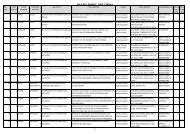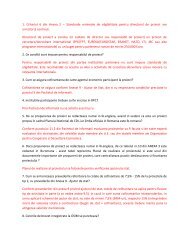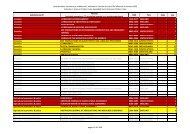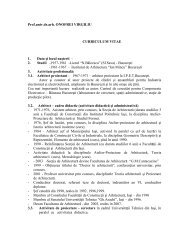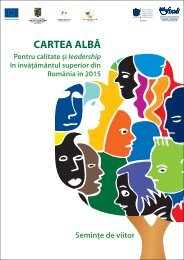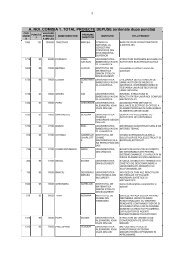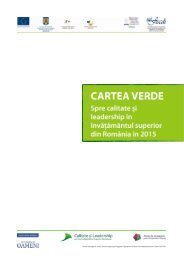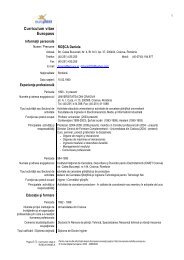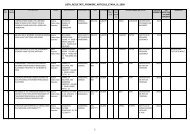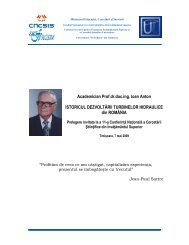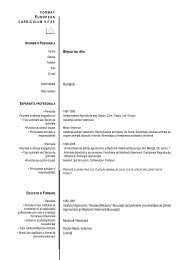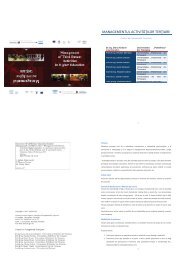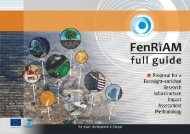Povesti de succes - uefiscdi
Povesti de succes - uefiscdi
Povesti de succes - uefiscdi
You also want an ePaper? Increase the reach of your titles
YUMPU automatically turns print PDFs into web optimized ePapers that Google loves.
Artă. Comunităţi Urbane. Mobilizare<br />
48<br />
Artă. Comunităţi Urbane. Mobilizare<br />
Profesor univ. dr. Ana Maria Zaharia<strong>de</strong><br />
Universitatea <strong>de</strong> Arhitectură şi Urbanism<br />
“Ion Mincu” Bucureşti<br />
Telefon:+40 21 3077178<br />
Fax: +40 21 3077178<br />
Email: Zaharia<strong>de</strong>.mail@gmail.com<br />
Scurtă prezentare a activităţii <strong>de</strong> cercetare<br />
Proiectul ARTĂ. COMUNITĂŢI URBANE. MOBI-<br />
LIZARE e <strong>de</strong>finit ca o cercetare orientată care şi-a propus<br />
unificarea, într-un cadru teoretic şi aplicativ interdisciplinar,<br />
a cunoaşterii cu privire la relaţia dintre arhitectură/urbanism,<br />
artă şi comunitate în spaţiul public.<br />
Proiectul se înscrie în câmpul (discursiv şi fizic) al spaţiului<br />
public contemporan, câmp vast şi greu <strong>de</strong>finibil, care<br />
constituie azi piatra <strong>de</strong> încercare a teoriei critice în relaţie cu<br />
filozofia, geografia, arta vizuală, studiile culturale şi sociologice<br />
şi proiectarea urbană. Zona specifică a cercetării se<br />
găseşte însă la intersecţia dintre edificarea/amenajarea spaţiului<br />
public, arhitectură/ urbanism, artă în general (arta socială<br />
şi <strong>de</strong> for public în special) şi modul în care le trăiesc<br />
comunităţile urbane. În interiorul acestei zone, procesele<br />
complexe <strong>de</strong> amenajare convoacă multiple competenţe şi interese<br />
- <strong>de</strong> la cele politice şi financiare la cele artistice şi la<br />
cele sociale - şi produc efecte diverse asupra celor care le<br />
experimentează.<br />
Astfel conturat, proiectul a presupus o reflecţie<br />
metodologică aparte, capabilă să a<strong>de</strong>cveze meto<strong>de</strong>le <strong>de</strong> cercetare<br />
complexităţii şi fluidităţii domeniului şi bogatei ţesături<br />
<strong>de</strong> relaţii dintre componentele sale. Dintre multiplele<br />
direcţii <strong>de</strong> abordare, grupul <strong>de</strong> cercetare care formează Consorţiul<br />
ACUM a ales trei linii majore <strong>de</strong> lucru, toate la fel <strong>de</strong><br />
fertile şi legitime în ordinea cercetării: (1) cea teoretică,<br />
analitică şi interpretativă, prin care încearcă să <strong>de</strong>zvăluie şi<br />
să “geometrizeze” potenţialul câmpului vast <strong>de</strong> relaţii pe<br />
Art. Urban Communities. Calls for Participation<br />
Broşura cuprin<strong>de</strong> materialele<br />
rezultateînurma <strong>de</strong>sfăşurării<br />
seminarului internaţional<br />
Edification <strong>de</strong>s lieux et<br />
paysage: prezentăricritice<br />
ale <strong>de</strong>liberărilorteoretice şi<br />
ale abordărilor situaţiilorreale<br />
prin propunerea unor<br />
intervenţii minimale al căror<br />
scop este recalificarea unor<br />
spaţii publice <strong>de</strong>structurateşi<br />
subutilizate din Bucureştişi<br />
din Sibiu.<br />
Edification <strong>de</strong>s lieux et paysage – The brochure contains materials from the international<br />
seminar Edification <strong>de</strong>s lieux et paysage: critique of the theoretical <strong>de</strong>bates and<br />
approaches to real cases by proposing minimal interventions whose goal is to re-<strong>de</strong>fine<br />
some <strong>de</strong>-structured or un<strong>de</strong>r-used public spaces from Bucharest and Sibiu.<br />
Brief Presentation of Research Activity<br />
The research project ART. URBAN COMMUNITIES.<br />
CALLS FOR PARTICIPATION is oriented to unify, within<br />
a theoretical and interdisciplinary framework, knowledge in<br />
matters like architecture/urban planning, art and community<br />
within public space.<br />
Thus, the project is part of the field (both discourse wise<br />
and physical) of the contemporary public space, vast and<br />
hard to capture as it is, which is the milestone of critical theory<br />
in relation to philosophy, geography, visual arts, cultural<br />
and sociological studies, and urban <strong>de</strong>sign. However, its<br />
Broşura cuprin<strong>de</strong> materiale<br />
suport pentru workshop-ul<br />
I[ntensive] P[rogram]<br />
Edification <strong>de</strong>s lieux et paysage,<br />
9-26 iulie 2006,<br />
Bucureşti şi Sibiu.<br />
The brochurecontains materials<br />
for the workshop<br />
I[ntensive] P[rogram] Edification<br />
<strong>de</strong>s lieux et paysage,<br />
July 9-26,<br />
Bucharest and Sibiu<br />
specificity lies at the crossroads of public space edification/<strong>de</strong>signed<br />
space, architecture/urbanism, art-in-general<br />
(social art and art for public forum in particular) and the way<br />
in which urban communities experience them. It is insi<strong>de</strong><br />
this area that complex processes of <strong>de</strong>signed spaces conjure<br />
up multifarious competence and interests, from political and<br />
financial to artistic and social ones, and impact those experiencing<br />
them in various ways.<br />
As it has been <strong>de</strong>lineated, the project assumed a special<br />
methodological reflection, able to adjust several research<br />
methods to the complexity, variability, and rich fabric of relationships<br />
among its components. Out of such multifarious<br />
approaches, the ACUM Consortium has chosen three directions,<br />
all fertile and legitimate in matters of research: (1) the<br />
theoretical, analytical and interpretative one, able to help reveal<br />
and find the ”geometry" of the potential within the vast<br />
area of relations contained by this space; (2) the one "in the<br />
mirror", by which the space turns into a background, a<br />
"décor" against which such relations work, a "screen" on<br />
which visual arts take their place in the most diverse manners;<br />
(3) the actionist one, where different types of triggered<br />
applications and events bring to light and enhance the space<br />
of such relationships. Each of these three directions echo a<br />
certain kind of oriented research that stays in between theoretical<br />
thought - in which knowledge comes first and is rel-



